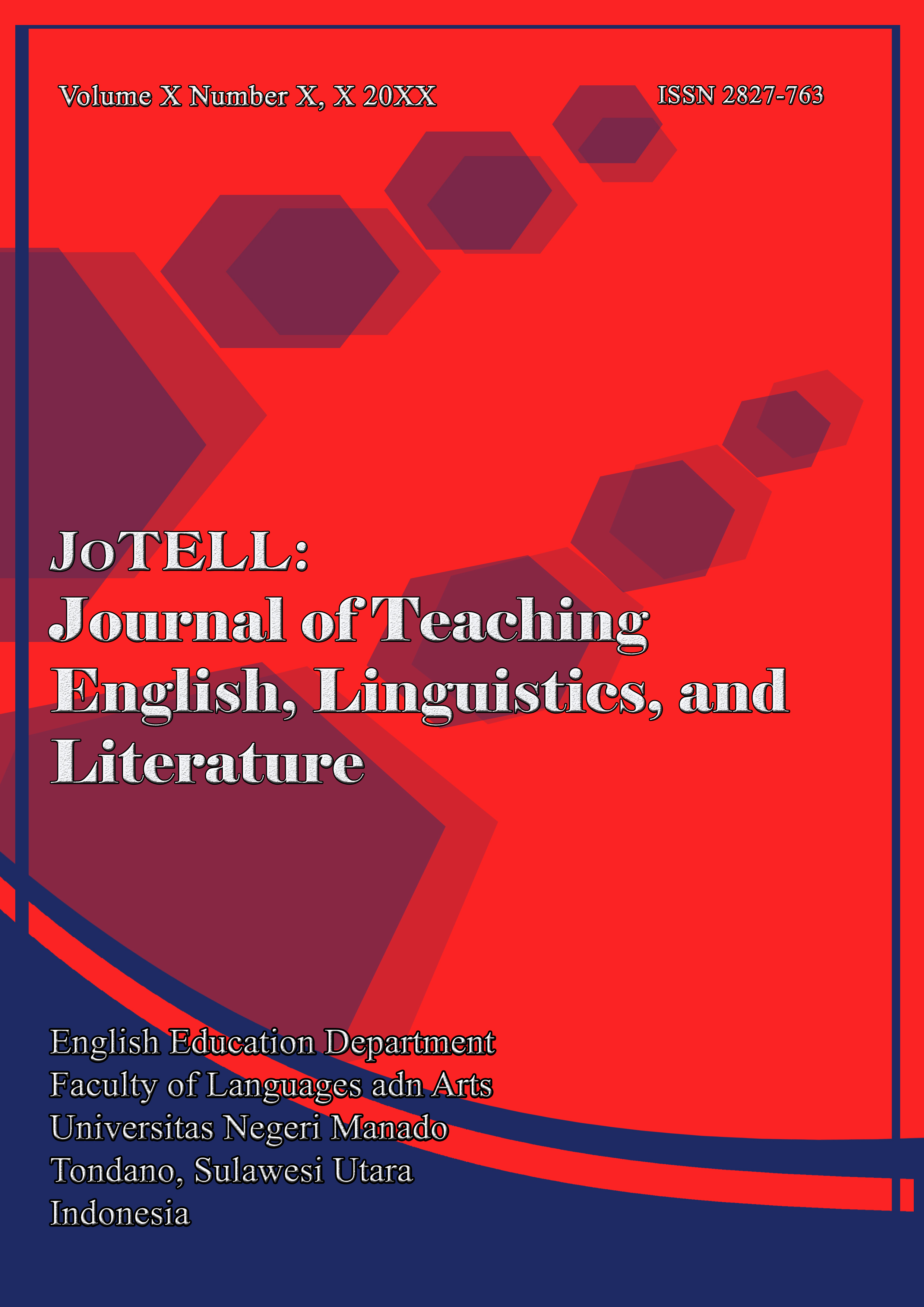IMPROVING STUDENTS’ VOCABULARY THROUGH AUDIO-VISUAL BY USING YOUTUBE VIDEOS AT SMA NEGERI 2 TONDANO
DOI:
https://doi.org/10.36582/jotell.v1i10.4730Keywords:
Vocabulary, Audio-Visual, YouTube, VideosAbstract
The purpose of this study was “to find out whether or not the use of audio visual by YouTube videos improves vocabularyâ€Â. This research was used quantitative research through pre-experimental research with one group pre-test and post-test design. Pre-test was a test which is given to the students before treatment. And post-test was a test which is given after treatment. There were 2 tests: T1 was the pre-test and T2 was post-test. X is used symbolize the treatment. This research was conducted SMA Negeri 2 Tondano especially tenth grade students (one class only). This school was used K-13 as their curriculum. After conducting the research, it could be concluded that the use audio visual by YouTube videos as the learning method to improve students’ vocabulary mastery is an effective way to solve the problem, when before applying the treatment they are lack in vocabulary mastery, especially the knowledge to know the meaning of each English words, the result showed the score in the post-test is significantly high than pre-test, not only that most of the students witness how helpful this method in their English learning activity such as reading, speaking and listening. The use of audio visual by YouTube indicated successfully influence the learning outcomes from each students, because they willing to improve and improve through utilizing their hobbies in watching YouTube while at the same time they can explore their English learning preferences in a proper way
References
Alqahtani. 2015. The importance of vocabulary in language learning and how to be taught. International Journal of Teaching and Education, III (3), pp. 21- 34.
Arikunto. 2010. Prosedur Penelitian (Suatu Pendekatan Praktek). Jakarta: Rineka Cipta
Arsyad, Azhar. 2003. Media Pembelajaran. Jakarta: PT Raja Grafindo Persada.
Arsyad, Azhar. 2008. Media Pembelajaran Audio Visual. Jakarta: Referensi Jakarta
Arsyad, Azhar. 2010. Learning Media. Jakarta: (Skripsi)
Bourdons, in Nunan 1993. Improving Vocabulary Abilty Using Comic. (Skripsi)
Burnett & Melissa. 2008. Youtube-Based Teaching and Learning of Arabic as Foreign Language (AFL). Vol. 17 No. 2, 2017
Callow, J., &Zammit, K. 2002. Visual literacy: from picture books to electronic texts. In M, Monteith (E.d), Teaching primary literacy with ICT Buckingham UK: Open University Press.
Cameron. 2004. The Importance of Vocabulary in Language Learning. International Journal of Teaching and Education Vol. III, No. 3 / 2015
Cameron, Lyne. 2005. Teaching language to Young Learners. New York: Cambridge University Press.
Daryanto. 2010. Media Pembelajaran. Yogyakarta: Gava Media.
Depdikbud, 1985. KamusBesarBahasa Indonesia, Jakarta: Balai Pustaka.
Furneux, C. L 1999. Vocabulary Teaching. In Johnson, K. & Johnson, H. Encyclopedic Dictionary of Applied Linguistics (pp. 367-369). Oxford: Blackwell.
Gay, L. R. (1981). Educational Research Competencies for Analysis and Application. London: Publishing Company.
Gay, L.R. Geofry e.mills. peter airasian. 2006. Eight edition: Educational Research Competencies for Analysis and Application. Ohio: Pearson
Greenbaum, S. and Nelson, G. 2002. An Introduction to English Grammar. London: Pearson Education Limited.
Hamalik, D. 2005. Media Pendidikan. Bandung: Alumni
Harmer, Jeremy. The Practice of English Language Teaching. London: Longman Group Uk. Limited. 1991.
Harmer. 2007. The Practice of English Language Teaching. Fourth Edition. England: Pearson Education Limited.
Hampp, P. L., Kumayas, T. A., & Lengkoan, F. (2021). Synthesizing Grammar and Structure Problems Faced by Indonesian TOEFL Takers. Jurnal Pendidikan Bahasa Inggris undiksha,9(1).
Ibrahim, M. T., Wuntu, C. N., & Lolowang, I. (2021). Struggle As Seen in Cassandra Clare’s The Mortal Instruments: City of Bones. SoCul: International Journal of Research in Social Cultural Issues, 1(2), 113-125.
Jacobs, G, Power, M, and Loh, W. 2002. The Teacher’s Sourcebook for Cooperative Learning. Thousand Oaks, CA: Corwin Press.
Khodareza & Komachali, E. 2012. The Effect of Using Vocabulary Flashcard on Iranian on Iranian Pre-University Students’ Vocabulary Knowledge. Canadian Center of Science and Educational Journal, 5 (3): 1344-147.
Lengkoan, F., & Hampp, P. L. (2022). Imitation Technique In Learning English At English Education Department Universitas Negeri Manado. Jurnal Pendidikan Bahasa Inggris Indonesia, 10(1), 48-53.
Liando, Nihta V. F. 2015. Students’ Vs. Teachers’ Perspectives on Best Teacher Characteristics in Efl Classrooms. TEFLIN journal
Liando, Nihta V. F. 2009. Students' perspectives on Motivation to learn English. Celt: A Journal of Culture, English Language Teaching.
Liando. Nihta V. F. 2012. Bilingual and Regular class Students’ Attitudes towards English. Yogyakarta: LITERA.
Liando, N. V. F., & Tatipang, D. P. (2022). English or Indonesian Language? Parents’ Perception Toward Children's Second Language Learning Context. Jurnal Lingua Idea, 13(1), 61-75.
Liando, N. V., Serhalawan, E., & Wuntu, C. (2021). Analysis of Teacher-Made Tests Used in Summative Evaluation at SMP Negeri 1 Tompaso. Jurnal Ilmiah Wahana Pendidikan, 7(8), 480-493.
Latief, M.A. 2013. Research Methods on Language Learning. An Introduction. Malang: UM Press.
Mamuko, Ephifania. 2017.The Use Of Video Blog To Learn English Vocabulary. Sarjana thesis, Universitas Brawijaya.
Mayer, R. 2001. Cognitive Principle of Multimedia Learning. The Role of Modality and contiguity. Journal of Educational Psychology.
Mulyasa. 2005. Didaktik dan Metodik Umum, Jakarta: PT Rineka Cipta.
Napa, Pieter A. 2005. Vocabulaary Development Skill. Yogyakarta: Kanisius.
Nunan. 1993. Improving the Students Speaking’ Speaking Ability Through Participant Point System (PPS) Method.
Rabiah, Sitti. 2012. Language as a tool for communication and cultural reality discloser. Faculty of Letter Universitas Muslim Indonesia, Makassar. (Journal)
Rahmah, Ferria Afia. 2015. The Effectiveness of Using English Songs from YouTube Towards Students’ Vocabulary Mastery. Jakarta: (Skripsi).
Safirah. 2016.Improving Vocabulary Mastery Through Vocabulary Cards of Grade VII Students at SMP Institut Indonesia Yogakarta in the 2015/ 2016 Academic year. (Skripsi).
Sugyono. 2017. Metode Penelitian Kuantitatif, Kualitatif dan R&D. Bandung: Alfabeta, CV.
Tatipang, D. P., Manuas, M. J., Wuntu, C. N., Rorintulus, O. A., & Lengkoan, F. (2022). EFL Students’ Perceptions of the Effective English Teacher Characteristics. Jurnal Pendidikan Bahasa Inggris undiksha, 10(1).
Tepa, Rorimpandey, Posuma. 2022. Improving Students’ Listening Skill by Using Songs’ Lyrics a Study Conducted at SMAN 1 Melonguane. JoTELL Journal of Teaching English, Linguistics, and Literature published by English Education Study Program, Faculty of Languages and Arts, Universitas Negeri Manado, Vol. 1 No. 2, pp. 244-260












